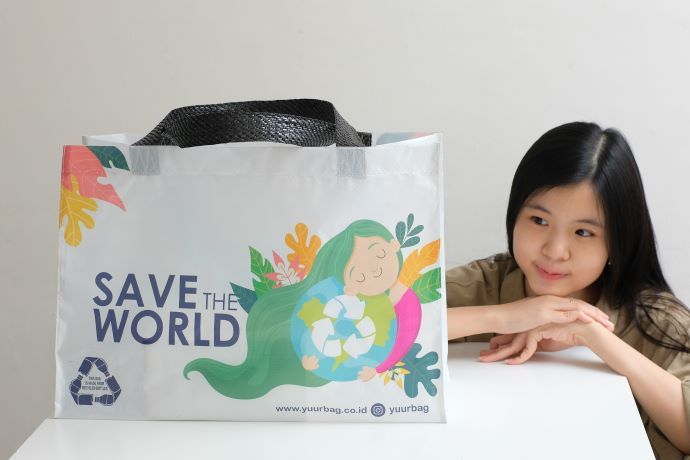How to Choose the Right Bulk Bag (FIBC) for Your Business
Key Takeaways:
- Choose the Right Type for Safety: Select from Type A to D bulk bags based on your material’s flammability and static sensitivity to ensure safe handling and transport.
- Match Bag Specs to Operations: Consider material, size, lifting loops, discharge features, and construction style to align with your product weight, flow, and storage needs.
- Optimize with Customization & Sustainability: Use custom-designed, reusable, and recyclable bulk bags from Langgeng Jaya Group to boost efficiency, reduce waste, and strengthen your brand.
Choosing the right bulk bag—also known as a Flexible Intermediate Bulk Container (FIBC)—is crucial for businesses handling large quantities of materials. The right choice can improve efficiency, reduce costs, and enhance workplace safety.
With so many options available, how do you select the best one? This guide will help you understand the different types of bulk bags, key factors to consider, and industry-specific recommendations.
Types of Bulk Bags (FIBCs)
Understanding the different types of bulk bags will help you select the most suitable option based on your materials and operational needs.
1. Type A Bulk Bags
- Non-conductive and suitable for carrying non-flammable dry goods
- No protection against static electricity
- Should only be used in environments without flammable dust or gases
2. Type B Bulk Bags
- Similar to Type A but with a lower breakdown voltage
- Reduces the risk of static discharge but does not eliminate it
- Suitable for environments with flammable dust but no flammable gases
3. Type C Bulk Bags
- Conductive bulk bags made with interwoven conductive threads
- Must be grounded during use
- Ideal for handling static-sensitive powders or granules
4. Type D Bulk Bags
- Anti-static bulk bags that dissipate static electricity without grounding
- Suitable for flammable powders and environments where grounding isn’t practical
Choosing the right bulk bag type ensures safety and efficiency in material handling.
Key Factors to Consider When Choosing a Bulk Bag
Selecting the right bulk bag involves considering several factors to ensure it meets your business needs.
1. Material Composition
- Most bulk bags are made from woven polypropylene (PP) or polyethylene (PE)
- Polypropylene bags offer high tensile strength
- Polyethylene bags provide better moisture resistance
Also Read: PP Bulk Bag vs. PE Bulk Bag - Which One is Best for You?
2. Size and Volume Requirements
- Bulk bags typically hold between 500 kg and 2000 kg of material
- Selecting the correct size prevents inefficiencies and ensures proper storage
3. Safety Standards
- Look for Safe Working Load (SWL) ratings (5:1 or 6:1)
- For hazardous materials, choose UN Certified Bulk Bags
4. Lifting Mechanisms
- Different lifting loop configurations (one, two, or four)
- Four-loop designs are the most common for flexible handling
5. Filling and Discharge Options
- Spout tops and bottoms help control material flow
- Choose options that match your loading and unloading process
Also Read : Mastering Bulk Bag Unloading - Challenges and Solutions
Bulk Bag Construction Styles
The construction style of a bulk bag affects its shape retention, stacking, and storage efficiency.
1. Circular Bulk Bags
- Woven in a tube shape, cost-effective but bulges when filled
- Used with cross-corner lifting loops
2. U-Panel Bulk Bags
- Made from two U-shaped panels, offering better shape retention
- More stable than circular bags for stacking
Read More: Circular vs. U-Panel FIBC / Bulk Bags - Which Is Better?
3. Four-Panel Bulk Bags
- Constructed from four separate fabric panels sewn together
- Holds a square shape better under load, making stacking easier
4. Baffle Bulk Bags
- Includes extra fabric panels (baffles) inside, ensuring a cube shape when filled
- Ideal for small, free-flowing materials like grains, fertilizers, or soybeans
Choosing the right construction style helps improve storage efficiency and transportation stability.
Also Read : Bulk Bags or FIBC Construction Types - A Complete Guide
Industry-Specific Bulk Bag Recommendations
Different industries require specific bulk bag solutions to ensure safety and efficiency.
Food and Pharmaceutical Industries
- ISO, BRC, and FDA-certified food-grade bulk bags for strict safety compliance
Chemical and Hazardous Materials
- Choose Type C or Type D bulk bags for safe static discharge handling
Construction and Agriculture
- Heavy-duty bulk bags are best for transporting sand, gravel, or grain
Understanding Bulk Bag Safety Labels and Certifications
Before purchasing a bulk bag, check for essential safety certifications:
- UN Certification for transporting hazardous materials
- ISO 21898 Compliance to ensure safety and durability
Environmental Impact and Sustainability of Bulk Bags
Sustainability is a growing concern for many industries. Bulk bags support eco-friendly initiatives through:
1. Recyclability
- Made from polypropylene and polyethylene, which are fully recyclable
2. Reusable Bulk Bags
- Reduce costs and waste by reusing bulk bags, following proper guidelines
Also Read : Reusable vs. Single-Use Bulk Bags - Which Fits Your Needs?
If sustainability is a priority, consider investing in recyclable or reusable bulk bags to reduce your environmental footprint.
Customizing Bulk Bags for Your Business
Every business has unique needs, and customization ensures your bulk bags align with your operations.
Customizable Options
- Langgeng Jaya Group provides custom bulk bags in different sizes, colors, and branding options
Worldwide Shipping
- Langgeng Jaya Group offers worldwide shipping, making them a reliable supplier for global businesses
Custom bulk bags help businesses improve efficiency and strengthen brand visibility.
Conclusion
Selecting the right bulk bag impacts your business’s efficiency, safety, and costs. By understanding different bulk bag types, material choices, and safety standards, you can make an informed decision.
Langgeng Jaya Group offers high-quality customizable bulk bags with global shipping options, ensuring your packaging needs are met with reliability and efficiency.



